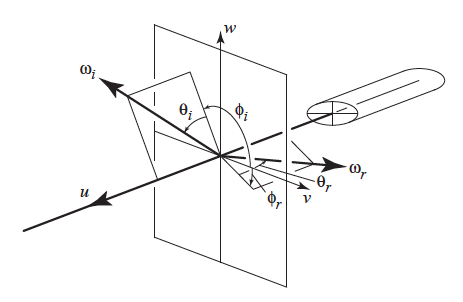As I had an opportunity to read and implement Marschner's paper [1] on the Marschner Model, I would like to share the details and points I have stumbled upon on reading the paper. The Marschner Model is a model proposed in 2003, that describes how light is scattered (reflected and transmitted) in human hair. It is used to implement shaders for human hair models, and rendering realistic hair.
[1] MARSCHNER, S. R., et al., 2003. Light scattering from human hair fibers. ACM Trans. Graph. 22, 3, 780–791. http://www.graphics.stanford.edu/papers/hair/
For conducting this survey, I've also referenced the following blog post:
Marschner Shader Part II | Real-Time Hair Simulation and Rendering
Overview
The Marschner Model is essentially a scattering function , which lets you find how much light is redirected from one direction to another. Simply put, it is the ratio of incoming light intensity from direction
against the outcoming light intensity from direction
. Given an outcoming direction
, it can be used as
to determine the amount of light emitted in that direction.
- Here,
is the intensity per *length* (which is different from ordinary *radiance*, which is intensity per *area*), which they call as *curve intensity*.
is the diameter of the hair - which implies that outcoming light increases for thicker hair, i.e. thicker hairs are more shiny.
- One novel point of the Marschner Model is that
is a function of only the *direction* of incidence, and not the *position* of incidence, meaning that the hair's thickness is *taken out of thought*. In the derivation, the hair's thickness (the position of ray-hair intersection) is explicitly considered, but is effectively ignored in its final form.

Figure 1. The coordinate system. Image cited from Marschner, et al. (2003) [1]
One important point that I've stumbled upon is the coordinate system. Although at first sight it seems like an ordinary spherical system with as the
direction, that is actually not the case. Here,
and
are measured as the inclination to the
-
plane. Therefore,
The same holds for
In the paper, the hair is modeled as an elliptic cylinder with a bumpy surface (which models cuticles). They first start with an ideal, smooth cylinder case, where is given as
Where is the delta function.
The term implies that scattering only occurs when
, which ultimately implies that an incoming straight ray is emitted in the shape of a cone.
We can see that is decomposed into
-dependent parts and
-dependent parts. This is one of the important features of this model, derived from the symmetry of the cylindric geometry of the hair.
The actual Marschner Model is an extention of this equation,
Although there are more terms, all emitted light is still contained in a single cone. The 3 terms represent the 3 modes of scattering that are considered (all modes are in the same cone). We can recognize that one major extension is the replacement of with
.
is one of the difficult parts of this paper. In this paper, simply put, *3D Fresnel effects are evaluated as 2D Fresnel effects with an augmented index of refraction,* thanks to the symmetry of hair (c.f. p. 6). We know that in Fresnel reflections/refractions, all light paths are contained in one plane. Obviously, this plane does not necessarily run parallel to the surface normal of the hair, and can be tilted (i.e., the plane may not cross the hair orthogonally). In this paper, the "3D" light path (on the tilted plane) is projected on to the plane perpendicular to the hair surface. Then, the Fresnel equations are evaluated *on the projected plane*, and then *projected back to the original tilted plane*. The augmented index of refraction, used on the projected plane, is
- which only depends on
due to the projection.
The Model
is a "unit-integral, zero-mean lobe function with width
" (c.f. p.8), i.e. simply a probability distribution
:
In the paper,
- The notation for the dependency of
on
is changed for clarity.
is complicated to find. First, as a notation, the paths
are given an index
, respectively. Then:
Here,
- We have additionally written the
-dependency of
and
.
- The notation of the sum and the arguments of
were changed for clarity.
- Confusingly, in the original paper there is a *variable*
and a *function*
which are different quantities.
is a trigonometric function (c.f. p.6) and is later approximated as
(c.f. p.8). For brevity, we will write
in place of the original function
.
Below, we will study the actual forms of each term.
Definition of  ,
,  :
:
,
are the corrected values of
:
Here, is a constant (c.f. p.8).
Definition of  :
:
is the corrected Fresnel reflectance function, computed with the corrected refraction indices
.
We know the ordinary Fresnel reflectance functions are given as:
The corrected Fresnel function
c.f. p.12:
...factor for oblique incidence may be computed from the projected angles by using
for the perpendicular component of the reflectance and a second index,
.
Finding  and
and  :
:
is found by solving a cubic equation. First define
Let
- It is mentioned (c.f. p.6) that for
, there may be one or three solutions to this equation, i.e. for the path
there may be multiple incident directions that end up being emitted in a specific direction.
For each solution of , we finally calculate
and
:
Finding  :
:
is the attenuation factor:
Where
Finding  :
:
Using the approximation,
Finding  :
:
Let us finally recall the form of :
One important fact is that the sum on the right hand side is taken over all solutions
The Grand Result
If we shall write the explicit form of one mode for the sake of reference (which becomes quite messy),
where